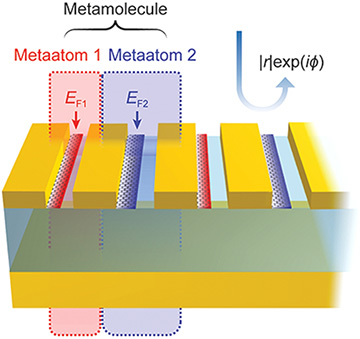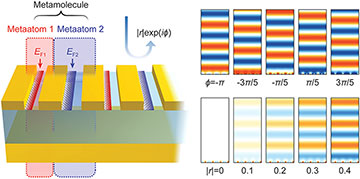
The researchers’ design consists of metamolecules consisting of paired graphene meta-atoms of different width, surrounded by gold nanoelements to enhance the light field and allow the application of independent gate voltages to individually tune the responses of the different meta-atoms. [Image: KAIST]
Active metasurfaces—flat, highly engineered optical elements decorated with nanostructures, or “meta-atoms,” and specifically designed to allow dynamic, tunable control and manipulation of light—have recently emerged as a frontier in metamaterials design. One challenge in this nanoscale realm, however, lies in fashioning surfaces for which both the phase and amplitude of light can be independently modulated at the same time.
Now, a team of researchers in Korea and the United States has proposed a strategy for designing and building wavefront-shaping active metasurfaces that allow both phase and amplitude to be electronically tuned (ACS Nano, doi: 10.1021/acsnano.9b09277). The team’s approach—which thus far has been tested out only numerically, and in the mid-infrared—rests fundamentally on thinking about such metasurfaces as collections not of meta-atoms, but of somewhat more complex “metamolecules.”
The researchers believe that such active surfaces could have applications in systems ranging from holography to beam-steering for lidar to variable-focus flat lenses.
Toward active metasurfaces
Wavefront engineering constitutes a fundamental need for a range of technologies in imaging, micromanipulation, communications and other areas—and that need has spawned an array of tools for achieving it, including bulk elements, modulators and MEMS devices. In the past several decades, metasurfaces have entered the wavefront-engineering mix. Most of these have been so-called passive metasurfaces, in which the specifics of the wavefront manipulation are baked in at the time of the material’s fabrication and can’t be dynamically tuned.
In recent years, researchers have increasingly eyed a new generation of so-called active metasurfaces. In these devices, the nanoscale meta-atoms that form the metasurface structure are built using electronically tunable materials, such as indium-tin oxide or the 2D material graphene; phase-change materials; thermo-optically tuned silicon; or other dynamically reconfigurable elements. (A nice review of these emerging materials was published in mid-2019.)
One challenge in creating these active metasurfaces, however, lies in controlling the full complex amplitude space—that is, in modulating both amplitude and phase as independent parameters. That’s because most metasurfaces include only one type of meta-atom, tuned to optimize a particular type of optical resonance. And modulating the phase of scattered light inevitably alters its scattered amplitude, limiting the ability to control both parameters independently.
From meta-atoms to metamolecules
In numerical experiments, the structure involving two different graphene meta-atoms allowed independent modulation of the phase (top right) and amplitude (bottom right) of an incoming light field. [Image: KAIST] [Enlarge image]
The team behind the new work—led by Min Seok Jang of the Korea Advanced Institute of Science and Technology (KAIST), and including other scientists at KAIST, the University of Wisconsin, USA, and the University of Minnesota, USA—sought a design approach for active metasurfaces that would enable simultaneous and independent modulation of both phase and amplitude. To do so, they homed in on the celebrated 2D material graphene as the enabling tunable platform. And they looked at designing not with meta-atoms, but with more complex metamolecules.
Specifically, the team’s design envisions a metasurface consisting of a periodic array of two-meta-atom metamolecules, consisting of graphene strips of different widths. The graphene strips, which produce strong plasmonic resonances, would serve as the key elements for modulating the complex amplitude of incoming mid-infrared (7-µm) light. Surrounding the graphene elements would be nanoscale strips of gold that would provide additional plasmonic enhancement of the local field. The array would sit atop an SiO2 substrate, backed by another, reflecting gold layer to boost the light-matter interactions in the top layer still further.
In addition to offering light-field enhancement, the metallic structures afford a route for electronically wiring up the two types of graphene meta-atoms in the metamolecule independently. That, in turn, allows for independent control of the plasmonic response of the two meta-atoms, by applying different gating voltages and thereby tuning the Fermi levels in the different meta-atoms individually. This provides, in the authors’ words, the “two degrees of freedom necessary for independently modulating the amplitude and the phase of the reflected light.”
Beam-steering and holography
The team subjected its active-metasurface design to numerical experiments to show its ability to dynamically redirect and reconstruct wavefronts from a point source, in two application contexts. One of those was active beam-steering, such as might be used in a tiny integrated component for automotive lidar. Here, the team’s simulations suggest, the design can—“unlike conventional spatial light modulators”—steer a beam across a wide angle without external optics for magnification.
The other application was holographic wavefront calculation and reconstruction for beam focusing. In this instance, the ability to simultaneously tune the simulated device’s amplitude and phase allowed “the generation of a clear and compact focal spot merely a single wavelength above the metasurface.”
Of course, so far, these spiffy devices exist only in computer simulations, and in the mid-infrared. But the team believes that its approach could offer a handy framework for designing active metasurfaces with complete complex-amplitude control in other wavelength bands as well. This, the researchers believe, could accelerate such surfaces’ use in a range of applications including beam-steerers for lidar, variable-focus flat lenses, and real-time holography. Toward that end, the authors also presented a graphical approach and “circuit-based” model that they believe will make the design of such metamolecule-based surfaces more intuitive.

